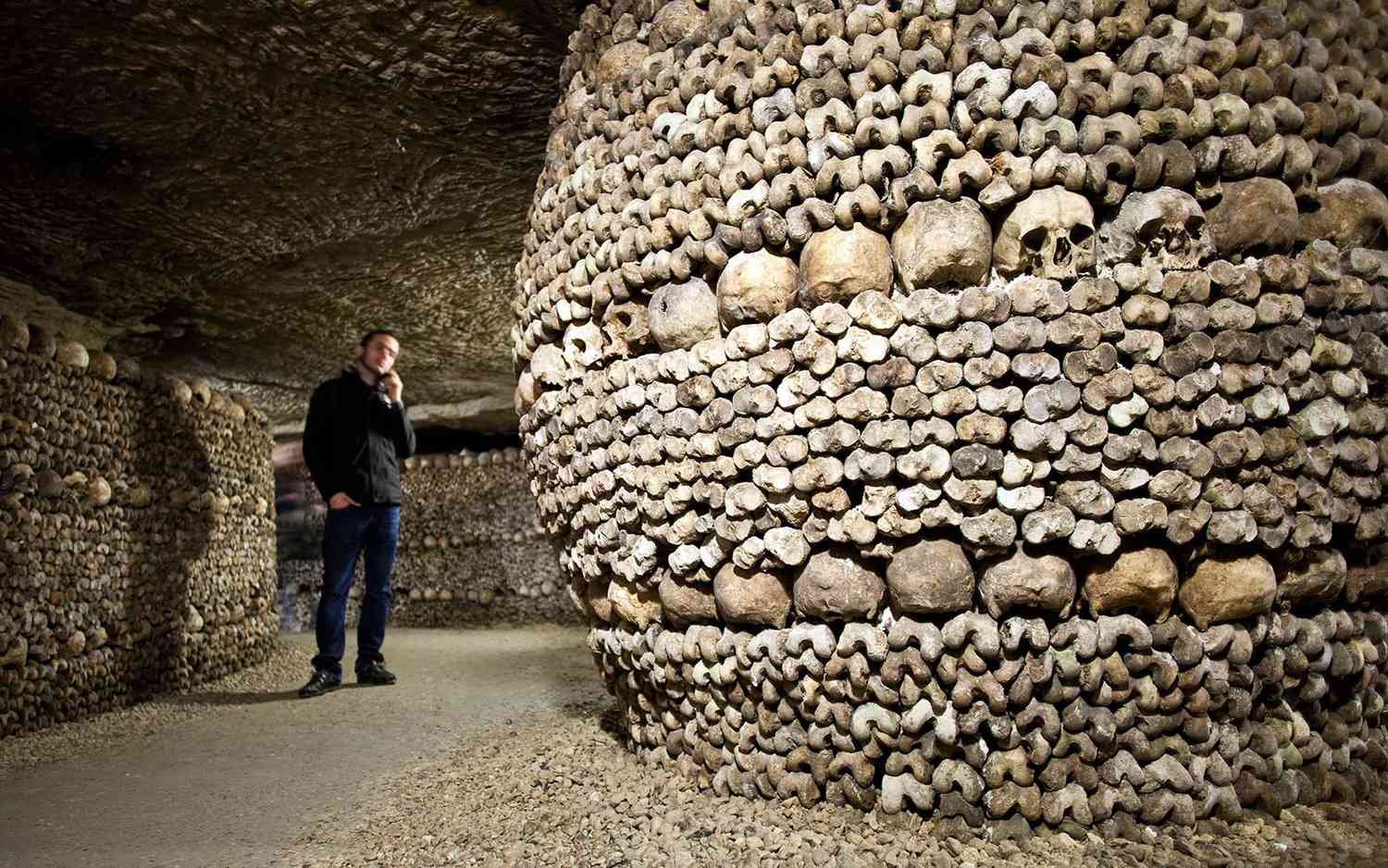
Ever wondered what lies beneath the bustling streets of Paris? The Paris Catacombs, a sprawling network of underground tunnels and chambers, hold the remains of over six million Parisians. Originally limestone quarries, these eerie passages became an ossuary in the late 18th century due to overcrowded cemeteries. Stretching approximately 300 kilometers, only a small portion is open to the public. Visitors descend 131 steps to explore this haunting yet educational site, greeted by a plaque that reads, "Stop, this is the Empire of Death." From secret parties to historical significance, the catacombs offer a unique glimpse into Paris's past.
Key Takeaways:
- The Paris Catacombs, originally limestone quarries, now hold the remains of over 6 million Parisians. Visitors can explore a small section, but secret communities and activities also exist underground.
- The catacombs played a significant role in history, from the French Revolution to World War II. Despite their haunting allure, visitors must respect the site's historical significance and follow safety rules.
The Origins and History of the Paris Catacombs
The Paris Catacombs have a rich history that dates back centuries. These underground tunnels have served various purposes over the years, from mining to being a final resting place for millions.
-
The Paris Catacombs were originally used as limestone quarries during the Gallo-Roman period. The inhabitants of Lutetia, the predecessor to modern-day Paris, tunneled for the Lutetian limestone deposits to construct their buildings.
-
The catacombs cover an area of approximately 800 hectares (almost 2000 acres) and are estimated to be around 300 kilometers (186 miles) long if laid out in a straight line. However, only a small portion of this vast network is open to the public.
-
The tunnels are located 65 feet (20 meters) underground, equivalent to the height of a five-story building. The layout of the tunnels reflects the Paris streets above, with some sections even featuring street signs from the past.
The Population of the Catacombs
The catacombs are not just tunnels; they are an ossuary containing the remains of millions of Parisians. This section explores the sheer scale and the reasons behind this massive underground cemetery.
-
The catacombs contain the remains of over six million Parisians. This massive collection of bones was moved from overcrowded cemeteries to the underground quarries between 1786 and 1860.
-
Only a small fraction of the catacombs is open to the public. The section that is accessible is known as the "Denfert-Rochereau Ossuary" and receives over 550,000 visitors annually.
-
Visitors can descend 131 steps to reach the catacombs, where they are greeted by a plaque that reads "Stop This is the Empire of Death" in French. The experience is both haunting and educational, with visitors able to see the bones arranged in patterns and murals.
Secret Communities and Activities
Beyond the public sections, the catacombs have a hidden world explored by adventurous Parisians known as cataphiles. These secret explorers have turned the tunnels into a playground for various activities.
-
Despite the dangers, many Parisians, known as "cataphiles," explore and map the uncharted sections of the catacombs. These secret communities have formed over the years, with some cataphiles engaging in activities like swimming and scuba diving in flooded sections.
-
Some sections of the catacombs are flooded, creating crystal-clear blue pools. Cataphiles often enjoy swimming or diving in these areas, adding to the surreal experience of exploring the underground tunnels.
-
The catacombs have also been known to host illegal parties, with some cataphiles organizing clandestine gatherings in the hidden passageways.
Historical Significance and Unique Features
The catacombs are not just a resting place for bones; they have played significant roles in history and contain unique features that make them a fascinating site.
-
The Paris Catacombs played a significant role during the French Revolution. In 1787, the future King Charles X organized a picnic in the catacombs with his courtiers and friends, marking one of the first recorded visits by a prominent figure.
-
Between 1810 and 1814, French politician and engineer Louis-Etienne Héricart de Thury arranged the bones into patterns, murals, and collages to honor the victims of the September massacres during the French Revolution.
-
By the mid-1700s, Paris's largest grave sites, such as the Holy Innocents' Cemetery, were becoming unsanitary due to overcrowding and frequent collapses. This led to the decision to move the remains to the underground quarries, which was completed by 1860.
-
During World War II, the catacombs served as a safe haven for persecuted citizens and members of the French Resistance. The tunnels provided a unique sanctuary from German forces, offering protection and hiding places for those seeking refuge.
-
The catacombs feature a large sculpture of the Port-Mahon fortress carved into the limestone walls, a testament to the historical use of the tunnels for mining materials.
Accessibility and Restrictions
While the catacombs are a popular tourist attraction, not all sections are accessible to the public. Safety and preservation are key concerns.
-
Certain sections of the catacombs are restricted from entry due to safety concerns and the need to preserve the historical integrity of the site. However, hidden throughout the city are secret openings, often former sewer access points, which cataphiles use to explore the uncharted areas.
-
Large portions of the catacombs remain uncharted and unmapped, with some areas being too difficult to access. This has led to numerous stories of people getting lost in the tunnels, including a tragic incident in 2017 where two teenagers were lost for three days before being found by fire service dogs.
-
The catacombs have been used for various economic activities over the years, including farming. In some sections, cataphiles have set up mushroom farms, adding to the diverse range of activities that take place underground.
Art and Culture in the Catacombs
The catacombs are not just a historical site; they have also inspired art and culture, attracting famous people and inspiring creative works.
-
The bones in the catacombs have been arranged in artistic depictions, including patterns and murals. This arrangement was intended to honor the victims of historical events and to create a sense of order amidst the chaos of death.
-
The Paris Catacombs have become a cultural icon, attracting famous people and inspiring artistic works. The catacombs' unique blend of history, art, and macabre fascination has made them a must-see attraction for many visitors.
-
Construction of tall buildings near the catacombs is prohibited to prevent damage to the tunnels and to maintain the structural integrity of the surrounding area.
-
Despite their macabre nature, the catacombs have a certain allure that draws visitors from around the world. The experience is often described as haunting and contemplative, inviting visitors to reflect on the transience of life.
-
The plaques with inscriptions and quotes found in the catacombs serve as reminders of the short time we have on earth. Walking past the thousands of bones invites contemplation on life and the inevitability of death.
Tourist Attractions and Tips
Visiting the catacombs is a unique experience, but there are other attractions and tips to consider when planning a trip to Paris.
-
The Paris Catacombs are one of the most popular tourist attractions in Paris, with visitors drawn to the unique blend of history, art, and macabre fascination. The experience is both educational and haunting, making it a must-see for many travelers.
-
After visiting the Paris Catacombs, visitors might also like to explore other underground cemeteries like Père Lachaise Cemetery or Calvaire Cemetery. The charming neighborhoods of Paris, such as le Marais, Saint Germain des Prés, Ile de la Cité, Ile Saint-Louis, Montmartre, and the 7th arrondissement, offer a wealth of cultural and historical experiences.
-
The preservation of the Paris Catacombs is crucial for maintaining their historical significance. Efforts are made to protect the site from damage and to ensure that future generations can continue to explore and learn from this unique underground world.
-
While the catacombs are primarily a place of historical significance, they have also been known to host clandestine parties. These events, organized by cataphiles, add to the mystique and allure of the underground tunnels.
-
In a bizarre incident, burglars penetrated the Paris Catacombs and stole a collection of exquisite wine worth $300,000 from an upscale apartment building near the Jardin du Luxembourg. This heist highlights the unique challenges of securing the catacombs and the surrounding areas.
-
One of the intriguing features of the catacombs is the black line on the ceiling, which indicates the water level. This line serves as a reminder of the tunnels' exposure to water and the potential for flooding in certain sections.
-
The ceilings in the catacombs are relatively low, ranging from 1.5 to 2 meters (4.9 to 6.6 feet) in height. This low ceiling adds to the sense of claustrophobia and emphasizes the vastness of the underground network.
-
The catacombs are remarkably quiet, with the only sound being the occasional dripping of water. This silence creates an eerie atmosphere that enhances the contemplative experience of exploring the tunnels.
-
The final bones and remains were placed in the catacombs in 1860, marking the end of the massive transfer of bodies from overcrowded cemeteries to the underground quarries.
-
Due to the presence of the catacombs, construction of tall buildings near the site is prohibited. This restriction aims to prevent damage to the tunnels and maintain the structural integrity of the surrounding area.
-
For those planning to visit Paris, it is essential to book popular attractions like the Seine cruise, the Louvre, and the Arc de Triomphe in advance. Additionally, visiting Versailles and Disneyland can be part of a comprehensive Paris itinerary.
-
Visitors should be aware of certain rules and restrictions when exploring the catacombs. For instance, touching the bones is strictly prohibited, and certain sections are closed to the public for safety reasons. It is also important to know that the catacombs are not the oldest in the world but have a unique historical significance that makes them a must-see attraction.
-
The Paris Catacombs are a fascinating and complex network of underground tunnels that offer a glimpse into the city's rich history and macabre fascination. From their origins as limestone quarries to their current status as a popular tourist attraction, the catacombs continue to captivate visitors with their unique blend of history, art, and mystery. Whether you are interested in history, architecture, or simply the surreal experience of exploring an underground ossuary, the Paris Catacombs are an unforgettable destination that invites contemplation on life and the transience of human existence.
Final Thoughts on Paris Catacombs
The Paris Catacombs are a mesmerizing blend of history, art, and eerie fascination. Stretching 300 kilometers beneath the city, this underground maze holds the remains of over six million Parisians. Originally limestone quarries, they became an ossuary in the late 18th century due to overcrowded cemeteries. Visitors can explore a small section, descending 131 steps into this "Empire of Death." The catacombs have seen everything from secret communities to illegal parties. They even played a role during World War II as a refuge for the French Resistance. Despite their macabre nature, the catacombs draw over 550,000 visitors annually, offering a haunting yet contemplative experience. Whether you're a history buff or just curious, the Paris Catacombs are a must-see, inviting you to ponder life's fleeting nature.
Frequently Asked Questions
Was this page helpful?
Our commitment to delivering trustworthy and engaging content is at the heart of what we do. Each fact on our site is contributed by real users like you, bringing a wealth of diverse insights and information. To ensure the highest standards of accuracy and reliability, our dedicated editors meticulously review each submission. This process guarantees that the facts we share are not only fascinating but also credible. Trust in our commitment to quality and authenticity as you explore and learn with us.


